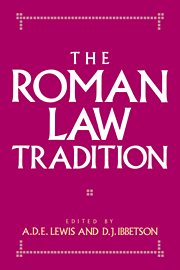Book contents
- Frontmatter
- Contents
- List of contributors
- Foreword: Peter Stein, Regius Professor of Civil Law in the University of Cambridge, 1968–1993
- List of abbreviations
- 1 The Roman law tradition
- 2 Labeo and the fraudulent slave
- 3 Doing and causing to be done
- 4 The danger of definition: contrectatio and appropriation
- 5 Going to the fair – Jacques de Révigny on possession
- 6 Bembo giureconsulto?
- 7 Gentilis and the interpretatio duplex
- 8 Ius gentium in the practice of the Court of Admiralty around 1600
- 9 Stair's title ‘Of Liberty and Servitude’
- 10 The actio communi dividundo in Roman and Scots law
- 11 Sale and transfer of title in Roman and Scots law
- 12 ‘What Marcellus says is against you’: Roman law and Common law
- 13 Audi et alteram partem: a limit to judicial activity
- Index of sources
- Index of names and subjects
6 - Bembo giureconsulto?
Published online by Cambridge University Press: 08 October 2009
- Frontmatter
- Contents
- List of contributors
- Foreword: Peter Stein, Regius Professor of Civil Law in the University of Cambridge, 1968–1993
- List of abbreviations
- 1 The Roman law tradition
- 2 Labeo and the fraudulent slave
- 3 Doing and causing to be done
- 4 The danger of definition: contrectatio and appropriation
- 5 Going to the fair – Jacques de Révigny on possession
- 6 Bembo giureconsulto?
- 7 Gentilis and the interpretatio duplex
- 8 Ius gentium in the practice of the Court of Admiralty around 1600
- 9 Stair's title ‘Of Liberty and Servitude’
- 10 The actio communi dividundo in Roman and Scots law
- 11 Sale and transfer of title in Roman and Scots law
- 12 ‘What Marcellus says is against you’: Roman law and Common law
- 13 Audi et alteram partem: a limit to judicial activity
- Index of sources
- Index of names and subjects
Summary
When Antonio Agustín arrived in Rome in the autumn of 1544, followed in the spring by his friend and collaborator Jean Matal, he had already formulated the amazing project of a corpus of the sources of civil and canon law; he was already the author of the Emendationum et Opinionum Libri IV and the Ad Modestinum, the fruit of his work on the Florentine manuscript of the Digest; and he had begun work on the De Legibus et Senatus Consultis. Central to the activity of the two in Rome was a continued search for manuscript copies of imperial constitutions and novels; but they also devoted a great deal of time and energy to an attempt to collect and arrange in order reliable copies of the inscriptions of the Roman world, which could furnish evidence for the Roman institutions which had produced the legal texts on which they worked.
Much of the material which they collected survives to reveal their methods of work, which attached high importance to the verification of copies against stone or bronze and to the assembly of parallels from juristic and literary texts: an annotated copy of Epigrammata Antiquae Urbis (Rome, 1521), now in the Biblioteca Apostolica Vaticana, MS Vat.Lat. 8495; and a series of notes and drafts for an epigraphic sylloge, which form part of five later miscellanies, MSS. Vat.Lat. 6034 and 6037–40. One of these, MS Vat.Lat. 6039, contains a curious text, in the form of a decree of the senate of Renaissance Rome.
- Type
- Chapter
- Information
- The Roman Law Tradition , pp. 98 - 103Publisher: Cambridge University PressPrint publication year: 1994

